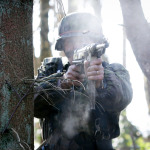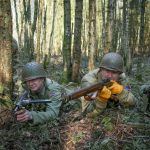A World War Two battle re-enactment group that rehearses its manoeuvres in Manchester is set to make a massive splash at a seaside 1940s festival on April 21-22.
The supercharged display will be put on by North West Military Collectors group (NWMIL), whose pyrotechnic experts strive to make the action as authentic as possible.
As part of their explosive exhibition they plan to submerge a controlled incendiary in the lake at Eirias Park in Colwyn Bay, North Wales – carefully timed to erupt in the water mid-battle on Saturday April 21.
NWMIL members are already practicing their combat manoeuvres, at Grange Farm woodlands in Worsley, Manchester.
Their military re-enactment was a bumper hit at last year’s Forties Festival and the members are looking forward to returning to the crowd-pulling two day pageant, which celebrates Colwyn Bay’s strategic war-time role in keeping Britain fed, when the Ministry of Food set up its HQ in the town’s hotels.
Many children from the Greater Manchester area and Merseyside were also evacuated to the Welsh coast to avoid German bombing raids.
One of NWMIL’s top battle strategists is Stuart Marsh, of Burnley, while, hailing from Salford, IT consultant Sam Berry, joined as a 16-year old and is still an enthusiast aged 31.
Tom Harrington, of Broughton, Salford, relishes dressing as a decorated US Army general and going into battle even though he is a pensioner.
Members go to great lengths to kit themselves out with authentic uniforms and battle gear, spending hard earned savings to look the part.
One of only a handful of women to join the battles is skilled Manchester-based artist and tattooist Kirsty Jones, who also designs impressive pin-up art seen on some members’ jackets and helmets.
She said: “It’s important we all have safety training and ensure we’ve registered first aiders among our ranks in case anyone trips or maybe sprains an ankle in battle. We’re extremely safety conscious but mishaps happen – not necessarily to do with weaponry but just the nature of the offensives we re-enact. For instance I once was role-playing an injured soldier being carried on a stretcher by comrades when one of them stumbled and we all went flying with the stretcher!”
Head of pyrotechnics Tom Craig from Burnley added: “These are not fancy dress but the real deal. It can take several years to build up a collection of kit including weapons, helmets and other militaria.”
Dressed as a private in the US 2nd Rangers, Tom was drawn into the group by a late friend.
Tom, the owner of Burnley electronics company RGS Electrical, said: “This was never something I imagined myself doing but I went to a few events, enjoyed them and became fascinated. That was three years ago, now I’m their lead pyro man.”
He attended an FX training course in Dewsbury to gain his pyrotechnics competency certificates and now helps plan manoeuvres involving explosives such as those which will be showcased at Colwyn Bay.
Health and Safety training is essential for all members as they carry live weapons, although fire blank ammunition. Guns and full kit are heavy, requiring immense stamina to carry – just as it did for Second World War troops – and many re-enactments take place on rough terrain.
Group founder and chairman Peter Hall from Flintshire in North Wales said: “We work hard to replicate battle scenes that are realistic, to honour the memory of those who served in the likes of Normandy, Dunkirk and Arnhem. All our members have a keen interest in military history, especially the Second World War. We’ve huge respect for the men and women who fought through those times.”
Peter, a self-employed joiner, has nurtured a life-long interest in the period and attended other re-enactment events before launching NWMIL 15 years ago.
“My wife Margaret, who is also an enthusiast, even bought me a Willys Jeep, which were used by the US Army in World War Two, for my 40th birthday!
“Most of us have the uniforms of our US allies, mainly because they are less heavy and less itchy than the British Army uniforms of that time. You’ll see three main squadrons: the Rangers, 82nd Airborne and the Armoured regiment. But we’ve also got a smaller platoon of Germans and even a Polish Partisan. They’re all genuine uniforms purchased to maintain our reputation for authenticity and most of us have spent a considerable chunk of savings on them.
“We’ve been to some of the biggest festivals in Britain and also mounted exhibitions abroad including in French Normandy, the Greek island of Crete, and in Bastogne, Belgium, where the Battle of the Bulge was.”
This year’s festival features full-sized replicas of a Spitfire and a Hurricane, with the town invaded by fans of the era, dressed in vintage style. Plus there will be displays of military vehicles, Llandudno’s tram and war-time weapons along with heritage tours. Colwyn Bay’s streets will host performances by Forties style performers plus local food producers, wartime ephemera and nostalgia items.
An evening of dance and music, Ballroom Blitz on Saturday April 21, takes place at the Barn in Zip World Stadium in Eirias Park, and features DJ Malcolm Murray, vintage singer Clara Bloom and the Ukulele Party Band with Reflections.
The festival, the seventh to be held, has been organised by the Bay of Colwyn Business Network and is backed by Bay of Colwyn Town Council, printers Powlsons plus Colwyn Business Improvement District (BID), which is aiming to revitalise the area.
Colwyn BID project manager Anna Openshaw said: “We are expecting thousands of visitors to the Forties Festival, when there will be plenty for families to enjoy, all free, on the streets of Colwyn Bay.
“North West Military Collectors group were a great hit last year so we are delighted they are returning again, and it sounds as though they have a real spectacular in store for everybody.
“For many older people the festival is a trip down memory lane, as they can recall the town when it was taken over by the Ministry. It’s also a chance for younger people to see what life was like for their relatives.”
The Forties Festival be a trip down memory lane for many of the town’s visitors and residents, from when Colwyn Bay played a key role in keeping war-time Britain fed.
The town became home to the Ministry of Food’s HQ with its head, businessman Lord Woolton, setting up his office in Colwyn Bay Hotel on the Promenade.
More than 5,000 staff moved to the town, launching campaigns such as Dig For Victory and overseeing the supply of food on the Home Front through ration books.
In 1940 the Ministry’s civil servants were moved from Whitehall to North Wales to escape the German bombing raids and free up space in London for the War Office.
They requisitioned 38 hotels in the town, including the fashionable Metropole, and The Queens, along with large houses as offices or places to live for the staff. At the Imperial officials monitored ships going into and out of Liverpool.
The Ministry’s bread division was based at the Edelweiss Hotel, the bacon and ham division at the Mount Stewart Hotel and the cocoa and chocolate department at the Colwyn Bay Hotel. The workers also took over Rydal School, which was evacuated to the Sychnant Pass in Conwy, and Penrhos College, with pupils moving to Chatsworth House in Derbyshire.
The last department – the Bakery Finance Division – left the town on 29 September 1956.
More about the event at Facebook/Colwyn Bay Forties Festival
For information on North West Military Collectors visit www.nwmil.co.uk




























